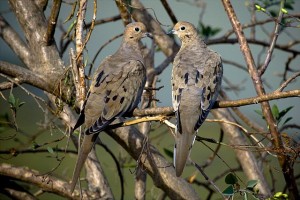Good Morning, Little Dove
The Iseum (space of worship) chartered through me by The Fellowship of Isis is called The Temple of the Doves. Why doves? The dove is one of the feathery creatures most beloved of the goddess, and a particular favorite of a divinity close to my heart: the goddess Ishtar.
Reverence for the dove is ancient and enduring, possibly extending back to the Stone Age. According to Marija Gimbutas, “Small birds were sculpted, engraved, and painted throughout prehistory. In Minoan Crete they appear perching on shrines, pillars, and the Goddess’s head. Unfortunately, it is not possible to recognize the species of birds portrayed, except in a very few cases.” Since doves and other pigeons like to roost in large buildings, and the first building complexes were places of worship, the religious significance of the dove may have grown up around the temple. Devotees would have assumed the doves came to bring messages from the sky gods or to carry prayers back to them. These doves would not have been exclusively the subjects and messengers of any god in particular, instead serving the deity of the temple where they lived.
As we move from decayed artifacts to religious writing, the sacred role of doves becomes less obscure. Sumerian hymns refer to doves as temple inhabitants and the dove plays an important role in both the Babylonian and Hebrew accounts of the Great Flood. Doves and other pigeons were commonly sacrificed in Mesopotamia, the Levant and (to a lesser extent) Egypt. Dove sacrifice was particularly important in early Judaism, and doves are the most frequently appearing birds in the Old Testament. Doves would have been sacrificial candidates due to their value (they were used for food and fertilizer) and their easy availabilty, but their temple association was probably a key component. The demand for sacrificial doves was so high that, inconceivable as it sounds, doves and other pigeons were actually bred in large numbers for the temples.
Scholars believe that the dove association with the Mesopotamian goddess Ishtar came late, which fits with my surmise that doves originally served many mistresses. Astarte, who is a fertility goddess like Ishtar, had an extensive cult throughout the Levant and is unquestionably linked with doves. Today it is the dove, rather than the original lion, that goddess worshippers most often associate with Ishtar. The dove’s plump, curving features, her gurgling coos and her soft, sweet melodies carry a voluptuous aura which naturally evokes this goddess of sexual love.
The early Christian sects, who worshipped a feminine form of wisdom they called Sophia, linked Sophia with the white dove, also one of Aphrodite’s many animal totems. Recognition of Sophia withered under patriarchal Christianity, though her worship has been revived in some of the more liberal churches. Her dove emblem continues as the symbol of the Holy Ghost.
Doves have always been close personal friends of mine. As a child, I would sit in my room listening to the mourning doves on the wires outside my window, and it felt like they were speaking to my heart. Even today, I think their music is one of the most beautiful and soothing sounds in nature.
Sources
Cooper, J.C. An Illustrated Encyclopedia of Traditional Symbols. London: Thames and Hudson, 1978.
Gimbutas, Marija. The Language of the Goddess. San Francisco: Harper & Row, 1989.
MacKenzie, Donald A. Myths of Babylonia and Assyria, 1915. Sacred Texts.
Walker, Barbara. The Woman’s Dictionary of Symbols and Sacred Objects. San Francisco: Harper & Row, 1985.
More information about the pigeon family here.

